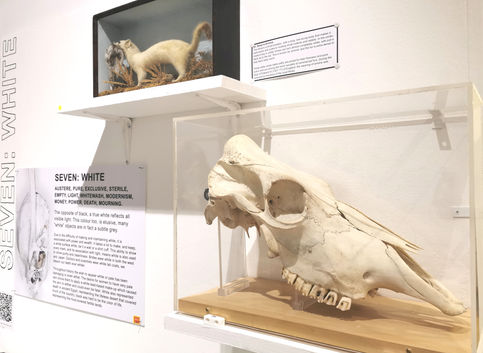Curation
Bone Black: A Brief History of Colour
Bringing together the worlds of art and science, this exhibition explored how people overcame the technical processes involved in creating colour and examined the origins of colour, whether from the natural world or human invention, with objects from minerals to textiles and everything in between. The exhibition included hands-on interactives exploring how each of us perceives and interacts with colours. Visitors were able to hear, smell and touch colours though a specially created sensory table, designed in partnership with Support 4 Sight. The interactives were made in collaboration with a range of local groups including Creative Walden, museum visitors, a local choir and the Community Shed. The interactive elements, along with an audio guide, aimed to make the exhibition more accessible for everyone including people living with sight loss and visual impairments. The exhibtion also featured the Museum's first full audio guide which could be accessed using a "Pen Friend" or QR codes.
The Lost Language of Nature
This exhibition took visitors on a journey to discover some of the Lost Language of Nature through the Saffron Walden Museum's historic taxidermy bird collection. The show featured over 25 newly conserved taxidermy specimens, some of which had not been out of storage for over 20 years. Visitors could see the diverse habitats in which these birds live across the world and discover some of the language and folklore which they have inspired, which historically has not featured in Museum records and displays. The exhibition was part of the wider “Lost Language of Nature Project” which aimed to re-engage the public with the lost words and stories of wildlife through research, storytelling, and the physical conservation work. Ongoing outreach work aims to correct the lack of input and knowledge from cultures that represent the source communities of items collected outside the UK, as well as find some of the lost language of specimens from the UK, such as folk names for common birds.
Worlds Under Glass: Adventures in Taxidermy
For hundreds of years, taxidermy has held a mirror up to our relationship with the natural world. From science to fashion, it has been a part of our culture since at the 1700s. The exhibition aimed to explore this fascinating relationship through the display of Saffron Walden Museum's impressive Natural History collection, including many pieces not usually public display. The exhibition combined examples of taxidermy that be considered crude in their technique, impressive displays of exotic birds, skins, and modern examples of taxidermy that capture character of specimens with incredible accuracy. It offered viewers a close look at a variety of fascinating specimens, as well as a glimpse into the taxidermist’s art through a display of materials and techniques. "Worlds Under Glass" helped visitors reflect on the subject of taxidermy and its place in our scientific, cultural, and natural heritage.
From Death Masks to Diaries: The Many Faces of Portraiture
From conventional examples such as paintings, photographs and busts; to diaries, death masks and finger prints, this exhibtion explored Saffron Walden Museum’s varied collections. Visitors discovered how portraits have been used throughout the centuries, from Ancient Egypt to today. The exhibition also brought together new objects as part of a project to create a portrait of Uttlesford now, reflecting the diverse lives of the people that call the district home. These new objects included over 60 life casts of the fingers/hands of members of the public, capturing their identity not only from their fingerprints but also their life’s story as shown through scars, callus, jewellery, injuries and arthritis. The Museum has worked with a number of community groups on the project including "Togther in Sound", Fairycroft's young writers group and "Come Together", a brand new intergenerational theatre initiative set up by Saffron Hall in 2020.
































